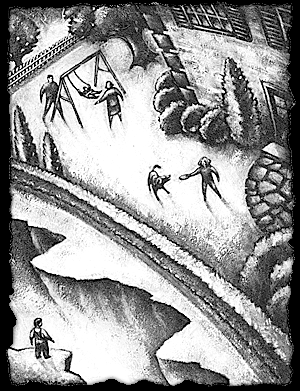- Economics
- Budget & Spending
- Politics, Institutions, and Public Opinion
John, 10, is one of America's children who waits. He waits for a home, and he has been waiting nearly all of his life. When John was a toddler, his drug-addicted mom lost her parental rights, and claimed not to know who the father was. John has been legally free to be adopted since he was three, but instead has lived in state-run foster homes and group homes. While his childhood slips away, John's social workers debate his best interests and the programs they hope will address them. But this skinny kid who loves baseball knows better: "I'm all wrapped up in programs," he says. "What I need is a mom."
Across the country, there are 50,000 foster children like John, who no longer live with their mother or father and have been declared by courts as free to be adopted, but who languish for months or years in state-run, state-funded substitute care. On any given day, nearly 400,000 other children-none of them eligible for adoption-can be found in government foster homes, group homes, and shelters. Many of them are kept there by absentee parents clinging to the legal rights to their children.
Foster care and adoption in America have sunk to a state of near-catastrophe.
According to the American Public Welfare Association, the population of children in substitute care is growing 33 times faster than the U.S. child population in general. During each of the past 10 years, more children have entered the system than exited. Every year, 15,000 children "graduate" from foster care by turning 18 with no permanent family; 40 percent of all foster children leaving the system end up on welfare, according to the American Civil Liberties Union.
What was for most of America's history an entirely private endeavor has become a massive, inefficient government system. State agencies consistently fail to recruit enough families for the children eligible for adoption every year; potential parents often are turned down because of racial considerations, or turned off by protracted and unnecessary waiting periods; cumbersome state regulations extend to private adoption agencies and can even prohibit private attorneys from handling adoptions. The result is that tens of thousands of children are now free to be adopted but have nowhere to go.
This is the dirty little secret of the welfare state: Every child is adoptable, and there are waiting lists of families ready to take in even the most emotionally troubled and physically handicapped children. Government adoption policies are utterly failing in their most basic purpose-to quickly place children who are free to be adopted into permanent homes.
The problem lies not with the children. What keeps kids like John bound to state care are the tentacles of a bureaucratic leviathan: a public funding scheme that rewards and extends poor-quality foster care; an anti-adoption bias that creates numerous legal and regulatory barriers; and a culture of victimization that places the whims of irresponsible parents above the well-being of their children.
I can identify with these kids. I was a foster child in a family that cared for 110 children. That family-my family-adopted me in the early 1970s. Years later, as a student at Harvard, I happened upon a book of statistics on children in state care. I was stunned to learn that decades of research, policymaking, and government funding had only intensified the system's failures. I was one of the lucky ones, but luck will not stem the tide of parentless children. By the year 2000, well over a million children will enter foster care, and tens of thousands of kids will become eligible for adoption. Unless the government apparatus of foster care and adoption is dismantled, these children could spend their childhoods wishing for what most people take for granted: stability, a family that will last longer than a few months, a last name.
Subsidizing
For years the rallying cry of many children's activists has been: "More money!" The National Commission on Family Foster Care, convened by the Child Welfare League of America, says that "family foster care and other child welfare services have never been given the resources necessary" to meet federal standards, and calls for a "fully funded array of child and family welfare services." When it comes to child welfare, rare is the research article that does not call for more money and further research.
America already is spending $10 billion a year on foster care and adoption services through public agencies. Federal dollars now account for nearly a third of all foster care funding, with most of the rest coming from state coffers. California alone spends at least $635 million a year on substitute care; the District of Columbia spent $53 million last year on a system that was so poorly run it recently was taken over by a federal court.
According to the ACLU, a year in foster care costs about $17,500 per child, including per-child payments to foster families and administrative costs of child welfare agencies. That does not include counseling and treatment programs for biological parents or foster parent recruitment and training. The San Francisco Chronicle reports that per-child costs for foster home or group home care have increased more than fourfold in the past decade.
The problem with foster care is not the level of government spending, it is the structure of that spending. The funding system gives child-welfare bureaucracies incentives to keep even free-to-be-adopted kids in state care. State-social-service agencies are neither rewarded for helping children find adoptive homes nor penalized for failing to do so in a reasonable amount of time. There is no financial incentive to recruit adoptive families. And as more children enter the system, so does the tax money to support them in substitute care.
By contrast, private adoption agencies are paid to find suitable families quickly, even if it means going out of state. The public social-service bureaucracy, nearly overwhelmed by other urban problems, has little to gain by devoting extra resources to adoption. Private adoption agencies are free to focus on finding homes for kids and are financially motivated to do so. Private adoption agencies are paid according to the number of successful placements; public agencies, in a sense, are paid for the number of children they prevent from being adopted.
There is a similar reward for foster parents to keep kids in state care. By law, adoption subsidies cannot exceed foster care payments, and in practice they are almost always lower. According to the National Foster Parent Association, foster families in 1993 received anywhere from $200 to $530 a month for each child under age 10, plus additional money from states and counties. The subsidies are tax free, and foster parents receive more money as the children under their care get older. So the longer the system fails to find permanent homes for kids, the more money flows to those fostering.
In some states, payments to foster parents caring for four kids equal the after-tax income of a $35,000-a-year job. The money is tax free. It doesn't take much imagination to see that paying people to parent can lead to mischief. Parents are not held accountable for how they spend their federal and state allocations; for too many foster parents, the children in their homes are reduced to mere income streams. If foster parents don't wish to adopt the children under their care, what incentive do they have to alert other parents hoping to adopt?
Let me be very clear: There are many dedicated and compassionate people in the foster care system, serving as case workers, counselors, and foster parents. My own experience in foster care was a positive one. But I have seen and heard of too many that were heartbreaking failures.
Special-Needs Stigma
I have heard perhaps a thousand times that the children who wait cannot be adopted because they have "special needs." Of course they do-they need parents. They require love and nurturing that endures. But the "special needs" referred to by advocates come with federal dollars attached. In 1980, Congress started offering states matching funds to assist the adoption of children with special needs, which included children of various ages, ethnic backgrounds, and those with severe mental and physical handicaps who may require expensive care. The subsidy was to become available only after a state determined that it could not reasonably expect to place a child without it.
As with so many other federal subsidies, states quickly expanded their slice of the government pie by broadening the criteria for receiving money. Today, nearly two- thirds of all foster children qualify. In some states, special-needs children include kids who have a sibling; are black, biracial, Hispanic, or Native American; are "older," as defined by the state; or have been in foster care longer than 18 months.
Two leading adoption organizations report that there are no national figures available that break down the type of need, or indicate the number of children who have physical or emotional handicaps that would require extra expenses by their new parents. This leaves the door wide open to all sorts of graft and fiscal abuse.
But there are other unintended and unconscionable consequences of this masquerade. One is that the needs of very vulnerable children are downplayed. The plight of a teen-age girl in a wheelchair who requires constant attention is trivialized when she is included in the same group as children whose "needs" are that they are eight years old. Another result-one I see often-is that local social-services departments discourage families from adopting by telling them, "Oh, these kids aren't for you. We only have special-needs children." This emphasis on kids with the most challenging emotional and physical handicaps unwittingly contributes to the false notion that foster children are "unadoptable." Ironically, the Adoption Assistance and Child Welfare Act of 1980 that established special-needs matching funds warned that children must not be "routinely classified as 'hard-to-place.'" Government funding has had just that effect, and it is helping to delay the placement of children ready for adoption.
I am convinced that the entire incentive structure for foster care and public agency adoption helps perpetuate the system's failure. It is a failure rooted in the notion that government funding is the panacea for family disintegration. The National Commission on Family Foster Care claims the foster care crisis is "the logical result of two decades of national neglect in providing funding and services for children, youths, and their families." On the contrary, as long as these children come with tax money attached-with little in the way of accountability-those invested in perpetuating the system will do little to reform it. As one foster child put it: "Everywhere I go, somebody gets money to keep me from having a mom and dad."
Anti-Adoption Bias
Government funding schemes and inefficiencies that prevent adoption exist within a larger framework: a steadily growing bias against adoption. Despite all the sociological evidence of the benefits of adoption, the conviction that a child does best in a permanent, loving, and stable home is all but missing from the ethos of state-run substitute care. How can this be?
In both the popular and elite media, a deep suspicion of adoption is all too evident. Marvin Olasky, a professor at the University of Texas at Austin, has noted that a New York Times series on adoption included such headlines as "The Ties that Traumatize" and "Adoption is Getting Some Harder Looks." And what do Playboy, Mirabella, and Good Housekeeping have in common? As Olasky says, each has joined the offensive with an article that warns readers against the "distasteful Ö bartering of lives" that supposedly is adoption.
Television writers would have us believe that adoption has no happy endings. TV portrays adoption as shady, risky, and shameful. Over the last year, a dozen programs featured adoption in their plots, and in every case the adoption agency was depicted as callously profit-driven. The adopting families were white, middle-class couples who kept secrets from the authorities or from each other. Birth mothers were unfairly portrayed as selfish or disturbed. The programs paid little attention to the well-being of the children.
Groups such as Concerned United Birthparents (CUB) help give legal expression to this bias. CUB was behind the "Baby Jessica" case that led to the removal of a two-year-old from her adoptive family. Groups like CUB claim that adoption is a feminist issue, that only the outmoded ideal of a two-parent family makes the notion of adoption palatable. As Olasky notes, Joss Sawyer's book Death by Adoption calls adoption "a violent act, a political act of aggression toward a woman."
Perhaps more significant, however, is the battle against transracial adoption that has been waged by the National Association of Black Social Workers (NABSW) for more than two decades. Its 1972 position paper reads: "Black children belong physically, psychologically, and culturally in Black families in order that they receive the total sense of themselves." Otherwise, the group claims, black children "will not have the background and knowledge which is necessary to survive in a racist society." Our institute has received letters from adoptive families in many states who have been barred from adopting transracially. According to the North American Council on Adoptable Children, state adoption laws may allow for race-matching, but "their preferencing policy isn't written down."
When it comes to transracial adoptions, there is no longer much doubt that current policies are bringing the greatest harm to the very community they were intended to help: African Americans. Just consider the numbers: Though black families adopt at very high rates, black children represent nearly half of foster kids waiting to be adopted. Fifteen percent of all children in America are black; but 40 percent of the children in foster care are black. State delays in finding homes for black children, as case workers search for "culturally consistent" placements, can keep kids languishing in state care for years.
"These policies are seriously harmful to black children, requiring that black kids who could get good homes be left in foster care," Harvard law professor Elizabeth Bartholet told the New York Times. "There is not an iota of evidence in all the empirical studies that transracial adoption does any harm at all.ÖThere is plenty of evidence that delay in adoption does do harm."
Such policies reveal a profound misunderstanding of the nature and effects of adoption. To insist that successful adoption means placing a child in a family of his racial or ethnic heritage is to overlook what every adopted child understands intuitively: Adoption is not easy. No matter how much a child's family looks like him, it does not alter the fact that someone gave him up. Having the same skin color as the people in his household doesn't automatically erase that. Only love does. As someone who grew up in a multi-ethnic family, I find it incomprehensible when people tell me that I cannot love my siblings the way I could if our skin color matched.
The Fallout
Attitudes against adoption, whether racially motivated or not, share at least two flaws. First, they ignore all the best evidence indicating that adoption leads to positive outcomes for kids. Last year, the Search Institute of Minneapolis released the largest study ever of adopted adolescents and their families (see table above). The study, in which 881 adopted children and 1,262 adoptive parents were surveyed, found that children who were adopted fared as well as or better than a national sample of non-adopted adolescents in self-esteem, mental health, school achievement-even the amount of time spent each week helping others. Adopted adolescents were more likely to agree or strongly agree with the statement "There is a lot of love in my family" than were non-adopted children.
Sociological studies of transracial adoptions are equally encouraging. Rita Simon of American University has conducted a 20-year longitudinal study of transracial adoption. She found that such adoptions cause none of the problems alleged by the NABSW. Rather, black children adopted into white families typically "grow up with a positive sense of their black identity and a knowledge of their history and culture." And such children, Simon says, often possess "special interpersonal talents and skills at bridging cultures."
Second, the anti-adoption movement fortifies the legal and bureaucratic obstacles that are keeping children from finding permanent homes. There are numerous state laws that needlessly complicate or block the process. In Minnesota, for example, if filing deadlines and other technical requirements of state adoption law are not precisely met, parents can be prevented for months or years from finalizing a child's adoption. Thanks to horror stories of baby-selling, four states have laws that ban independent adoptions (though exceptions are permitted). Despite this, more than 45,000 adoptions in 1992 were conducted through private agencies or independent agents-the vast majority of them successfully.
My office receives numerous letters from people eager to adopt but frustrated by laws and bureaucrats. One woman recently wrote: "My husband and I decided we would like to adopt a little girl, thinking we had a lot of love, nurturing, and stability to give a child who had been abandoned or abused. Almost immediately I hit a brick wall." Her local department of social services-in a state with more than 5,000 foster children free to be adopted-told her it was "not taking new cases" of families willing to adopt foster children. A couple wrote that of their three adopted children, "two [had] lingered in foster care, one of whom we were not able to adopt until he was age 18."
Adoptable You
There is at least one other mistaken notion that feeds the legal and cultural bias against adoption-the idea that many of the children in foster care are simply not adoptable. My own experience suggests otherwise, as I was an older child when my foster parents adopted me. And my experience with parents in and outside the foster care system tells me that every child is adoptable.
For every child who is ready for a permanent home, there are families waiting. It is time to shatter the myth that adoptive parents are interested only in "healthy white babies." There are waiting lists to adopt white children, black children, Hispanic children, infants and teens, children with Down's syndrome and with AIDS. Private agencies for years have found families for all types of children. Adopt a Special Kid, a California-based service, receives more than 1,500 inquiries annually from families interested in adopting children with disabilities. The National Adoption Center maintains a computerized listing of 650 qualified families waiting to embrace disabled "older" children. The center reports that infants, even the most severely disabled, are adopted almost immediately.
Outside of the thousands of families who have successfully completed home studies and have registered with with their states, there are no hard figures for the number of parents able and willing to adopt. Certainly there are families who would come forward if public agencies recruited more aggressively. Beginning in November, 1993, Massachusetts stepped up its recruitment efforts with public-service announcements, an aggressive media campaign, adoption "open houses," and community-based recruitment. Such efforts helped increase foster child adoptions by 47 percent in one year.
Most people know someone who has gone to heroic lengths to adopt. Americans adopted more than 7,300 children from other countries in 1993, according to the U.S. Immigration and Naturalization Service. The INS estimates that the 1994 figure exceeds 8,000. Others have spent their life savings to offer permanence to a child; domestic adoption through private agencies or independent attorneys can cost more than $30,000. It is not unusual for foster parents to adopt two, five, or even 10 children under their care. Clearly, the barriers to adoption are neither the characteristics of children who wait nor the parents who want to care for them.
The Route to Foster Care
In addition to the 50,000 children who today are legally free to be adopted, there are hundreds of thousands more who drift for days, months, or years within the state-run system-a system that too often guarantees a parentless future for some of society's most vulnerable members.
Children enter foster care for a variety of reasons. Mom abuses or neglects one of her kids, dad is using drugs or is arrested for a felony, or perhaps the parents are just having a hard time coping with the responsibilities of parenthood. The American Public Welfare Association reports that 70 percent of foster children enter the system because of abuse, neglect, or "parental conditions"-including drug addiction, incarceration, illness, or death. More than 600,000 kids will spend all or part of 1995 in substitute care, up from 434,000 in 1982.
A profile of children in state care belies the stigma that foster children are mostly "unadoptable" troubled teens. Researchers at the Chapin Hall Center for Children at the University of Chicago studied five states whose foster care children make up about half of the U.S. foster care population. They found that from 1990 to 1992, nearly 25 percent of all first admissions to foster care were babies less than one year old. Between 1983 and 1992, the proportion of 12- to 15-year-olds entering substitute care in those states declined. The American Public Welfare Association cites similar trends.
Sadly, the youngest children remain in the system the longest. The University of Chicago study revealed that, after controlling for other factors, children who enter foster care as infants remain in the system 22 percent longer than other young children.
The fact remains, however, that foster care is failing children of all ages. The ACLU reports that one in 10 foster children remains in state care longer than 7.4 years. At least 40,600 foster children have been in care for five years or longer; another 51,300 have been in care between three and five years. System kids, on average, live with three different families, though 10 or more placements is not uncommon. "Every new placement is a loss," says Michael B. Pines, a psychologist specializing in attachment disorders. "The result is that these kids begin not to trust anyone."
Paid to Parent
One of the reasons that foster care tends to ensnare children in a legal and emotional limbo is that its bureaucracy and incentive system attract parents who are unable or unwilling to adopt or help find homes for the children in their care.
Whether adopting through private or public adoption agencies, would-be parents must undergo a home study. Private agencies, which must successfully place children in homes to stay in business, are free to set higher standards for parents than public agencies do. Christian or other faith-based adoption agencies typically emphasize tough standards of behavior. But this is not so for state-run substitute care. In many states, adults who fail the adoption home study get a consolation prize: They can become foster parents. Deemed unworthy to serve as legal adoptive parents, these adults are then paid handsomely to raise children in state care.
Foster homes, group homes, and public orphanages share another vice: Their government money comes with regulations attached. This often guarantees confusion and conflict. Private orphanages always have been driven by a mission: keep girls from getting pregnant, keep children in school, expose children to the Christian faith, and so on. They use a combination of rules and rewards, discipline and love to fulfill their mission. Often, this isn't allowed in a state-run group home, where it may be against the law to hug a child, or to lock the door after midnight, or even to advertise for a married couple to serve as housemasters.
If a permanent, loving family is the surest route to producing happy, well-adjusted children, then what effect does the foster care system, at its worst, have on countless kids? The result of the system's delays, incentive structure, and regulatory grip is that many former foster children ultimately remain dependent on state services. They are wildly over-represented among welfare recipients, the homeless, and in juvenile and adult prison populations. In Los Angeles County, 39 percent of homeless youth are former foster children. In New York, 23 percent of the homeless were once in foster care; in Minneapolis, the figure is 38 percent. According to the Bureau of Justice Statistics, former foster children make up nearly 14 percent of America's prison population.
Culture of Victimization
The financial disincentives to adoption and the legal and societal biases against it do not exist in a vacuum; they are rooted in the soil of victimization. More than half of the children who enter foster care were abused or neglected in their families of origin. But the current system grants "victim status" to these parents. It often allows them to cling to their parental rights as they move in and out of social service programs. As a result, tens of thousands of children remain trapped in foster care, never free to be adopted into stable, loving homes.
Take the case of Halie (not her real name), a two-year-old girl who one day wouldn't eat her dinner. Her mother and mother's boyfriend tied her to an electric heater. Hours passed, until Halie's face, chest, and arm were disfigured. Her mother then threw her into a cold shower, dressed her, and took her to a hospital-claiming the child had spilled hot water on herself. After weeks of hospitalization, Halie entered foster care. For the next 10 years, her biological mother-coached by the local department of social services-maintained her legal rights to the child. Case workers helped Halie's mom to toe the official line to prove she somehow was still capable as a parent: She married her boyfriend and had a child with him.
When Halie was 12, her case workers and a judge approved overnight and extended visits between Halie and her biological mother. Halie's mother rejected a judge's offer to regain custody. She didn't want to raise Halie, but didn't want to let her go, and the state gave her all the legal and financial help she needed. Halie spent her teen years in group homes and foster homes. She turned 18 in foster care.
Most states give biological parents every possible chance to prove they are fit-while their babies grow up in state care. A family recently wrote me about their two-year-old foster daughter: "She is precious beyond belief, and her parents are being given chance upon chance to clean up their lives-at her expense, as we see it. She is so adoptable by the right family, but the system will keep her under lock and key for years if necessary for her parents' benefit."
In our social-work schools, counseling centers, and government-funded research, the culture of victimization insists that the most despicable behavior by abusive parents has its causes in economics, racism, broken homes-anything but the consciences and moral choices of men and women. We have devised a foster care system that puts a vogue pop psychology ahead of the well-being of children. This helps explain why roughly a third of all the foster children who are reunited with their families of origin soon return to state care. Indeed, it is the only explanation for some of the bizarre attempts I have seen to reunite a foster child with a parent who is clearly unwilling or unfit.
Under federal law, states cannot obtain federal funds for foster care unless "reasonable efforts" are made to keep members of the family of origin together ("family preservation") or to reunite the family ( "family reunification"). But the federal government nowhere defines "reasonable efforts," and only a few states have specific statutes. It's a classic Catch-22: Children are not free to be adopted until every reasonable effort is made to return them to their biological parents. But almost no one seems to know what constitutes a reasonable effort, that is, what services must be offered to parents who need outside help.
When, for example, a public agency reports to a judge that a mother has failed her drug-treatment program, the judge is likely to insist that the mom enter every drug treatment program available. So biological parents are given multiple chances to fail at parenting, while children may bounce between state care and their family of origin. The Department of Health and Human Services (HHS) admits that the inability to meet "reasonable efforts" standards is the primary barrier to foster child adoption.
From my own experience in foster care, the most difficult part was watching my brothers and sisters return to biological parents who had burned or beaten them, or put out cigarettes on their children's bottoms. I felt like an accomplice. It must have been hard for my parents, who could do nothing to stop it.
Most foster parents, at one point or another, must relinquish a child to a home situation that is precarious. One foster mother of five years wrote: "I have been seriously reconsidering my position as a foster parent because when we started this it was to try to help these children, and I am finding out that I am not able to do that. The pain and heartbreak of not being able to protect these children is a heavy burden to bear." Until the system is reshaped, it is a burden that every one of us carries.
Assignment: Adoption
It is one thing to tolerate inefficiencies and bureaucratic delays in other areas of public life-public toll roads, for example. Such inefficiencies don't cost children 18 years of their lives. We do not need another study, or blue-ribbon commission, or congressional subcommittee hearing. When I was four years old, it didn't matter to me that someone was getting a research grant to study the effects of foster care on childhood development. What I wanted was a last name.
I am convinced that there are more parents willing to adopt than there are children ready to be adopted. But the market for adoption is frustrated by the regulatory system now in place. To create a more efficient system, one with incentives to help rather than abandon innocent children, we must get Big Government out of the business of parenting. I do not mean we should create a market in babies. I am not talking about baby-selling. I am talking about serving babies and children by removing the barriers to their enjoyment of stable, loving homes.
Where parts of foster care and adoption are privately run, competition and incentives have led to better outcomes for children. In Michigan, where two-thirds of foster care management is privatized, private providers spend less per child, yet have achieved better social worker-to-child ratios than those of state-run agencies. Adoption is, in fact, the ultimate form of privatization: wresting authority over children's lives from the state and allowing children to be free, to be raised not by government but by parents.
We must reform, state by state, our system of transferring parental rights-from the government, which can never be a parent, to parents who are eager and able to bring these children into their hearts and lives. Congress recently has taken interest in adoption reform by proposing a $5,000 tax credit for adoptive parents. But will that tax credit get children out of foster care more quickly? No. Does it stimulate a market in private adoptions? No. Does it allow independent adoptions in states where they are now outlawed? No.
Tax credits might make adoption a little easier for some parents, but they will not make adoption work. To do that, we need reform at the federal and state levels-bureaucratic reform that will shatter the incentive structure that traps kids in foster care, and legal reform that will free children who already have spent years in substitute care. In Massachusetts, we call it "Assignment: Adoption," a comprehensive plan that our institute is bringing before federal lawmakers and state governors:
Hold states accountable for reporting their progress in finding homes for children in foster care. Here is one federal mandate that states ought to be obliged to take on. Washington should require that states make publicly available, within 30 days of the close of each fiscal year, the following information: (1) the number of foster children in state care; (2) the number of foster children free to be adopted and still in state care, but not in pre-adoptive placements; (3) the number of state-recruited families with completed home studies.
Most conservatives right now wouldn't touch a federal mandate with a 10-foot pole. I would prefer to see an entirely private system that includes a strong charitable element. Until that happens, a few basic requirements on the states are in order. We're talking about giving children a mother and a father. And until we know the depth of the problem in each state, until the number of kids waiting for homes becomes part of our thinking and vocabulary, state agencies are unlikely to change. There are people in our state departments of social services who know these numbers, but we're not hearing them.
Prohibit race-based delays in adoption. Congressional attempts to outlaw race-matching in adoption have yet to free tens of thousands of children of color from foster care. This summer, the U.S. Senate will consider a welfare-reform bill that prohibits race-based delays in adoption. Even if Congress approves the bill, its impact could be minimal.
Recall that the Multiethnic Placement Act of 1994, sponsored by former U.S. Senator Howard Metzenbaum, had a similar goal, but it was watered down. Under guidelines released by HHS in April, the new law allows adoption agencies to consider the child's "cultural, ethnic, and racial background." As reported by the Washington Post, the guidelines "stopped far short of requiring that adoption must be colorblind."
It is at this point that the discrepancies between legal precedent, public policy, and social-work practices become painfully clear. The HHS guidelines have not overturned any state laws requiring that race be considered in adoption. And with vaguely written state statutes, case workers will continue to have a lot of power over whether a child will be adopted or languish in long-term "temporary" care.
Suppose every state had adoption policies that were truly colorblind. We at the Institute for Children are challenging governors to remove any and all restrictions to adoption based on race. What would happen if thousands of children of color grew up in white or mixed-race families? It would produce an amazing generation of young people who, instead of growing up without a last name or a permanent home, were raised by loving parents in a diverse, multicultural environment. Why are some black leaders so afraid of that? If their real agenda is the well-being of children, then the evidence is in. Children are infinitely better off in a loving, interracial home than as virtual orphans in foster care.
End government funding that creates incentives to keep children in substitute care for longer than 12 months. Part of the problem is that government money extends indefinitely, with no sanctions enforced against bureaucratic delays. The Adoption Assistance and Child Welfare Act of 1980 required a "permanency plan" for every child within 18 months of entering foster care. This means that case workers decide whether to reunite a child with his family, place him in long-term fostering, an independent living arrangement, a group home, or make him free for adoption. Adoption is the permanency plan for 100,000 foster children, but no one knows how often these plans result in permanent homes for children.
Deadlines for permanency plans come and go, court dates are postponed, files are lost as children are shuffled among foster families. A federal study reveals that children spend, on average, 30 to 42 months in foster care before adoption is even decided on as a permanency plan. Once that happens, the state files a petition to terminate parental rights; the filing can take another six months or more. A report by HHS admits that in some states "children had an official plan of adoption for more than three years, but no petitions had been filed."
The result is that in probably every state there are children who have been in foster care longer than 10 years. Meanwhile, the money to support children in state-run care keeps coming, with no consequences to the state bureaucracies that fail to place children.
Require that states find adoptive homes for children within 30 days after the termination of parental rights. The foster child who is freed for adoption typically has been in the system for at least two years and has had a permanency plan of adoption for at least one year. Yet, as children become legally free to be adopted, states claim to need more time to find families for them! Our institute recommends a 30-day window: If the state does not have a qualified family waiting, one who has met the child and is ready to proceed with the adoption, then state officials must contract out the adoption process to a private agency. Qualified families exist in large numbers, and private adoption agencies are pretty good at finding them. Three years ago, Michigan launched a carrot-and-stick program with public and private adoption agencies to get kids into permanent homes more quickly. Since then, total adoptions are up, and the number of black children adopted has increased by 121 percent-about 700 kids in the past year alone.
Critics call this baby-selling and claim that government should not act like a business. As someone who has seen the machinery of the state from the inside, I argue that government could promote children's well-being much more effectively if it acted more like a business. I am not alone in noting the failure of foster care management. The director of the ACLU's Children's Rights Project recently wrote, "If the foster care system were considered a business, with its profit-and-loss statements judged in terms of unnecessary human suffering inflicted by mismanaged systems, in terms of misspent dollars, or even in terms of how far these systems depart from their own goals, it would have been forced into bankruptcy long ago."
Getting Kids Out of Limbo
All of the above reforms are aimed at getting the children now eligible for adoption into permanent homes as quickly as possible. But there are more than 600,000 children in foster care at some point during the year. Most of those kids are happily reunited with their parents. Many of them, however, become trapped in the state-run system-children who are never free to be adopted, but who will not or should not return to their biological parents. There are at least three steps every governor could take to rescue these children from the worst effects of foster care and help them find a home:
Make entrance requirements for foster families as stringent as those for adoptive families. In the wake of a wave of child deaths in foster care, people are beginning to speak out about the need to raise the standards for being licensed as a foster parent. As one advocate put it, to be a foster parent "all you need is a clean criminal record and an extra bed." People who have failed an adoption home study can sign up with the state as foster parents. Foster children deserve better than that.
Critics argue that if we raise the requirements for foster families, there won't be enough qualified people to take care of the kids. I have more confidence in the generosity of the American people. I think if you raise the requirements, you'll see more foster parents and better care. Look, for example, at private schools with higher requirements and lower teacher salaries than public schools; they continue to attract excellent teachers and deliver a quality education. By maintaining a separate set of standards for foster parents than those for adoptive parents, we are saying to a half-million kids that it is not important where they spend the most formative years of their lives.
But this is not the only disgrace in foster-parent licensing and training procedures. In state-sponsored training courses, foster parents are admonished, "Do not get too close to your foster children. Do not form a bond." Foster parents are instructed that their main task is to facilitate a child's return to his or her biological parents. From day one, good foster parents are discouraged from adopting.
Certainly there is a stigma attached to being a foster parent-the system has created it. It is that stigma that discourages many capable and loving people from fostering. If the entrance requirements for fostering were as high as those for adopting, foster children would be better cared for. The anti-adoption establishment wouldn't like it, because it would ruin the standard argument that foster parents are not adequate to adopt.
Allow no more than 12 months for biological parents to prove their fitness to resume custody of their children. This may be the most difficult law to pass at the state level, but it also may be the most desperately needed. State laws can be so vaguely written and so easily assailable that termination of parental rights is always a last resort and can take years of court hearings. There are many in the field who believe it is almost always better to send children back to their natural parents. The Child Welfare League promotes the notion that "no one can truly substitute for the family of origin."
I agree that nature provides every child with two protectors-a man and a woman-and that we're meant to be with our biological parents. But nature didn't design women's bodies to endure crack cocaine; it didn't design children to be shaken until they suffer cerebral hemorrhages. Family preservation doesn't work in these cases because there is nothing left to preserve.
State governors should take the lead in setting tough sanctions against parents who neglect or abuse their kids. By setting a deadline for parents to get their lives together-to get off drugs, get out of jail, find a place to live, and even get a job or go to school-we remind them that they really are responsible for their actions. But the deadline must be final and incontestable; otherwise, irresponsible parents will continue to imprison their children in a labyrinth of legal battles and parentless foster care. The 12-month limit has yet to be adopted by any state and is indeed a radical departure from the years it can now take to legally separate a child from unfit parents.
Allow no more than 30 days from the birth of the child for biological fathers to formalize paternity. The "Baby Jessica" and "Baby Richard" cases have demonstrated the law's allowance for biological fathers who come out of the woodwork to claim their children after they've been adopted. In the now pending "Baby Emily" case, a little girl born in 1992 was soon placed for adoption after the father's rights were terminated for abandonment (he was doing jail time for a rape conviction). But now the father is out of prison and has sued for custody of his daughter. The adoptive family's finances have been completely exhausted as the case awaits adjudication in Florida's supreme court.
Governor William Weld of Massachusetts has sent to the legislature a proposal that, if passed, will prevent such tragic cases in Massachusetts. The proposal requires every unwed biological father to formalize paternity within 30 days of the child's birth, and to maintain contact with the child and provide financial support to the best of his ability-or forfeit his right to contest the child's adoption. Ideally, that would mean no appeals, no hearings, no state officials pulling children out of their adoptive homes. The legislation, if not severely amended, could serve as a model for state reform.
A Life That Matters
A teenage girl-we'll call her Sarah-who worked for our institute last summer was a system kid; she had turned 18 in foster care. This was her first job and she was surprised when she noticed that taxes had been taken out of her paycheck. She asked me what the government would do with her money. In my usual non-partisan spirit, I explained how the federal government would spend the $300 withheld from her summer earnings. She actually started to cry. She looked at me and asked, "Will it go to pay for foster care?" She said it hurt her that she had worked so hard only to help the government keep some other child from being adopted.
That's what the system is doing to our children. Though my own experience in foster care was a good one, it opened my eyes to the real hardships of countless children. My foster brothers and sisters who might have gone back safely to their families of origin too often and for too long were delayed from doing so. Others lived the saddest stories of rejection-they had been burned, beaten, sodomized or battered, left in a doorway or in a fruit field, but later sent "home" to their abusers. Like foster children everywhere, many who could have been adopted were denied the chance to be loved and cherished by a family who would always be there.
Let's be honest: Adoption is no fairy tale. It is a risk. Kids don't always go home and live happily ever after. But every parentless child knows the alternative: the feeling that there is no one to whom her "case"-that is, her life-really matters.
When parents adopt, they can accomplish something government cannot: They can convince a child she matters. That's what makes adoption such a great gift, an expression of unconditional love and compassion. Don't we, as a society, owe that gift to our children?
















